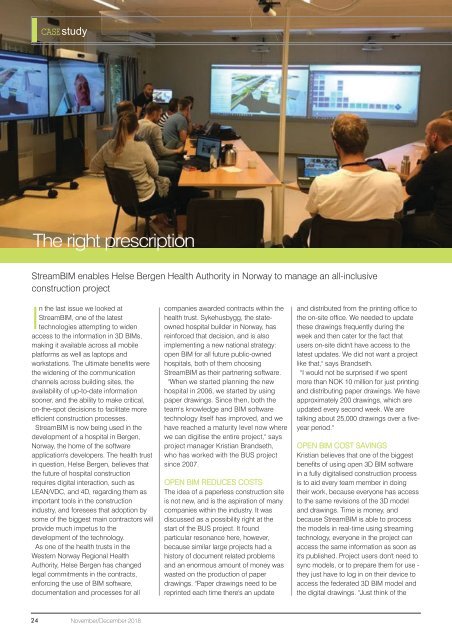CU1811
You also want an ePaper? Increase the reach of your titles
YUMPU automatically turns print PDFs into web optimized ePapers that Google loves.
CASE study<br />
The right prescription<br />
StreamBIM enables Helse Bergen Health Authority in Norway to manage an all-inclusive<br />
construction project<br />
In the last issue we looked at<br />
StreamBIM, one of the latest<br />
technologies attempting to widen<br />
access to the information in 3D BIMs,<br />
making it available across all mobile<br />
platforms as well as laptops and<br />
workstations. The ultimate benefits were<br />
the widening of the communication<br />
channels across building sites, the<br />
availability of up-to-date information<br />
sooner, and the ability to make critical,<br />
on-the-spot decisions to facilitate more<br />
efficient construction processes.<br />
StreamBIM is now being used in the<br />
development of a hospital in Bergen,<br />
Norway, the home of the software<br />
application's developers. The health trust<br />
in question, Helse Bergen, believes that<br />
the future of hospital construction<br />
requires digital interaction, such as<br />
LEAN/VDC, and 4D, regarding them as<br />
important tools in the construction<br />
industry, and foresees that adoption by<br />
some of the biggest main contractors will<br />
provide much impetus to the<br />
development of the technology.<br />
As one of the health trusts in the<br />
Western Norway Regional Health<br />
Authority, Helse Bergen has changed<br />
legal commitments in the contracts,<br />
enforcing the use of BIM software,<br />
documentation and processes for all<br />
companies awarded contracts within the<br />
health trust. Sykehusbygg, the stateowned<br />
hospital builder in Norway, has<br />
reinforced that decision, and is also<br />
implementing a new national strategy:<br />
open BIM for all future public-owned<br />
hospitals, both of them choosing<br />
StreamBIM as their partnering software.<br />
"When we started planning the new<br />
hospital in 2006, we started by using<br />
paper drawings. Since then, both the<br />
team's knowledge and BIM software<br />
technology itself has improved, and we<br />
have reached a maturity level now where<br />
we can digitise the entire project," says<br />
project manager Kristian Brandseth,<br />
who has worked with the BUS project<br />
since 2007.<br />
OPEN BIM REDUCES COSTS<br />
The idea of a paperless construction site<br />
is not new, and is the aspiration of many<br />
companies within the industry. It was<br />
discussed as a possibility right at the<br />
start of the BUS project. It found<br />
particular resonance here, however,<br />
because similar large projects had a<br />
history of document related problems<br />
and an enormous amount of money was<br />
wasted on the production of paper<br />
drawings. "Paper drawings need to be<br />
reprinted each time there's an update<br />
and distributed from the printing office to<br />
the on-site office. We needed to update<br />
these drawings frequently during the<br />
week and then cater for the fact that<br />
users on-site didn't have access to the<br />
latest updates. We did not want a project<br />
like that," says Brandseth.<br />
"I would not be surprised if we spent<br />
more than NOK 10 million for just printing<br />
and distributing paper drawings. We have<br />
approximately 200 drawings, which are<br />
updated every second week. We are<br />
talking about 25,000 drawings over a fiveyear<br />
period."<br />
OPEN BIM COST SAVINGS<br />
Kristian believes that one of the biggest<br />
benefits of using open 3D BIM software<br />
in a fully digitalised construction process<br />
is to aid every team member in doing<br />
their work, because everyone has access<br />
to the same revisions of the 3D model<br />
and drawings. Time is money, and<br />
because StreamBIM is able to process<br />
the models in real-time using streaming<br />
technology, everyone in the project can<br />
access the same information as soon as<br />
it's published. Project users don't need to<br />
sync models, or to prepare them for use -<br />
they just have to log in on their device to<br />
access the federated 3D BIM model and<br />
the digital drawings. "Just think of the<br />
24<br />
November/December 2018

















